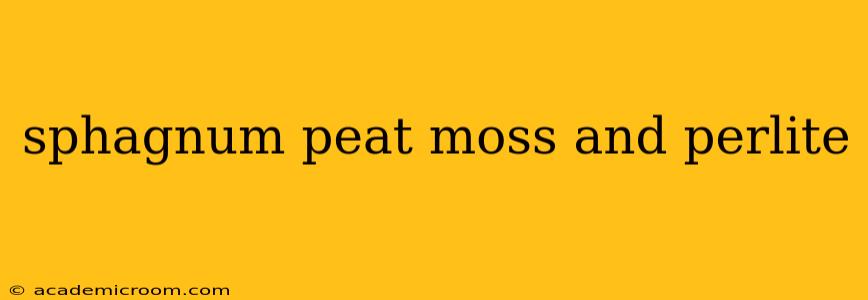Sphagnum peat moss and perlite are two incredibly popular growing medium components, often used together to create the perfect soil blend for a wide variety of plants. But what makes them so effective, and how do they work together? This comprehensive guide explores the individual properties of sphagnum peat moss and perlite, their benefits when combined, and answers some frequently asked questions.
What is Sphagnum Peat Moss?
Sphagnum peat moss originates from partially decayed sphagnum moss, a type of moss that thrives in bogs and wetlands. It's prized for its exceptional water retention capabilities, excellent aeration, and slightly acidic pH, which many plants prefer. The decomposition process is slow, resulting in a material rich in organic matter, providing essential nutrients for plant growth. However, it's important to note that while it holds water well, it doesn't hold onto nutrients as effectively as some other soil amendments.
What is Perlite?
Unlike peat moss, perlite is an inorganic material. It's a volcanic glass that's been heated to a high temperature, causing it to expand into small, white beads. These beads are lightweight, porous, and provide excellent drainage and aeration to the soil. Perlite doesn't retain water itself, but it helps to create spaces within the soil mix, allowing for better air circulation around the roots and preventing waterlogging.
Why Combine Sphagnum Peat Moss and Perlite?
The magic happens when you combine sphagnum peat moss and perlite. They complement each other perfectly, creating a growing medium with the optimal balance of water retention and aeration. The peat moss provides the moisture-holding capacity, while the perlite ensures proper drainage and prevents root rot, a common problem caused by overly saturated soil. This combination is particularly beneficial for plants that require consistently moist but well-draining soil.
What are the benefits of using sphagnum peat moss and perlite together?
- Improved Drainage: Perlite prevents waterlogging, ensuring the roots get enough oxygen.
- Enhanced Water Retention: Peat moss holds moisture, reducing the frequency of watering.
- Optimal Aeration: The combination allows for good air circulation around the roots.
- Better Root Growth: A well-aerated and consistently moist environment promotes healthy root development.
- Nutrient Retention (to a degree): While peat moss doesn't hold nutrients as strongly as some other mediums, the structure created by the combination allows for better nutrient availability.
- Suitable pH: The slightly acidic pH of peat moss is ideal for many plants.
What are the different ratios of sphagnum peat moss and perlite?
The ideal ratio of sphagnum peat moss and perlite depends on the specific plant's needs and the overall soil mix. Generally, a 1:1 ratio (equal parts peat moss and perlite) is a good starting point for many plants. However, some plants might benefit from a higher proportion of peat moss for better moisture retention, while others might require more perlite for superior drainage. Always research the specific needs of your plants before mixing your own growing medium.
Is sphagnum peat moss and perlite good for all plants?
While the combination of sphagnum peat moss and perlite works wonderfully for many plants, it's not universally suitable. Some plants prefer a different soil pH or drainage characteristics. For example, cacti and succulents generally thrive in much more well-draining mixes with less peat moss. Always consult resources specific to your chosen plant species for optimal growing medium recommendations.
What are some alternatives to sphagnum peat moss?
Concerns about the environmental impact of harvesting sphagnum peat moss have led to the exploration of alternative growing mediums. Coco coir, a byproduct of coconut harvesting, is a popular sustainable alternative that offers similar water retention and aeration properties. Other alternatives include vermiculite, composted bark, and various mixes of these materials. The best alternative will depend on your specific needs and preferences.
Conclusion
The combination of sphagnum peat moss and perlite offers a versatile and effective growing medium for a wide array of plants. By understanding their individual properties and how they complement each other, you can create the perfect soil blend to support healthy root growth and thriving plants. Remember to always consider the specific needs of your plant species when determining the optimal ratio of these two essential components.
